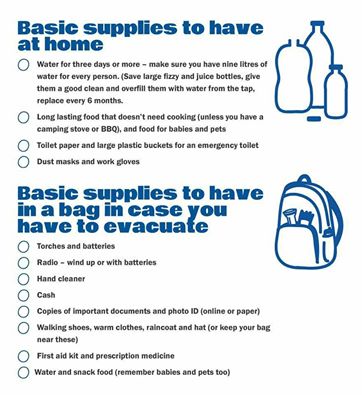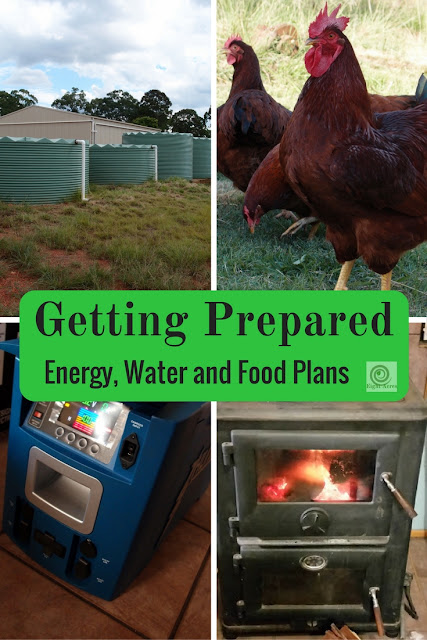Getting prepared
The prepping tendency is possibly also because I grew up in New Zealand, where its normal to stockpile bottles of water and have a "bug out bag"! I remember seeing instructions like the image below in the phonebook when I was a kid. The NZ recent earthquakes are a good reminder to review your preparations.
Energy supply in an emergency
We primarily need energy for keeping food cool, cooking and heating the house in winter. While we were very tempted to build our secondhand house with off-grid solar, it just wasn't practical, so this is what we've done instead.
We have a grid connection for running our fridges and freezers (which are important to our food plan below). If we lose grid power, we have a petrol powered generator which will run two freezers and the fridge. We have had to use that when we have lost power at various times during summer, and it worked ok, but was very loud and had to be turned off at night.
The main problem is that it does use petrol, a couple of litres a day, and if we can't get into town to buy more fuel we would eventually run out (we try to keep about 40 litres here).
Long term, our plan is to have grid-connected solar panels on our shed, these will be connected to an inverter which will disconnect from the grid if it goes dead (most solar systems go dead when the grid goes dead, to protect electrical workers, so you have to specifically get one that will continue to run your house). We will have the freezers on a circuit fed from the solar panels so that they would at least be able to run during the day.
In the meantime, we also just bought a stand-alone battery box, which can be charged by our car, mains electricity or solar panels, and has both DC outputs for charging phones etc and a small AC inverter. This will be primarily for camping and driving holidays, but is going to be good to bring inside and run lights and charge a few things if we lose grid power. We also got a 40L fridge that will run off the battery pack, so that we can keep a few things cold if we run out of generator fuel.
For heating and cooking we have our woodstove. We also have a gas BBQ and gas cooktop in the kitchen. But if we run out of gas, we can always use wood as we have plenty. We will be installing solar hot water and are considering a wet-back from the woodstove as well.
We also tried to build our secondhand house with as many passive heating and cooling features as possible, so that we are not relying on air conditioning to keep us comfortable in summer. It can be a bit hot without the ceiling fans running, but so far the insulation, light coloured roof and solar shading seems to help.
Providing food in an emergency situation
Rather than stockpile food, which will eventually run out or go off, I prefer to have my food "on the hoof" or in the garden (as OFG used to say). This means that it doesn't need to be stored for as long and you can always make more if needed. For the garden, this means being self-sufficient for all inputs, including compost for fertility, mulch and saving seeds. A great resource is also our local share group where we can swap local seeds.
For meat, we have the beef steers that we kill once a year or so and lots of chickens. Eventually we would also like to try keeping goats or sheep and pigs. The smaller animals do not require as much freezer space and will be more manageable for Pete and I to butcher ourselves.
We also have more space and pasture on our property now, which reduces our inputs of hay and grain to feed the animals. I will eventually be planting a food forest and lots of forage for chickens to reduce their need for grain. We are also keen to set up aquaponics (fish and veges) fed from meal worms and compost worms.
Water supply in an emergency
Without water, nothing else will work. This is part of the reason that we wanted to move to a larger property with better water catchment and more dams, as the dam here at Eight Acres is small, salty and goes dry.
At Cheslyn Rise we have been focusing on developing water infrastructure. For stock and garden purposes we have several large dams near the house and our solar bore. For human consumption we have four 20,000L tanks fed from the roofs of the house and shed, with a water filter in the kitchen.
Our last step is to make sure the water can be fed from the tanks when the power goes out, so we will be installing a header tank with a solar pump as back up to top up the header.
Mitigating Damage
As well as all of this, we have tried to design the house placement so that it was away from flood danger (on top of a hill) and mitigate bushfire risk by removing trees near the house, installing a dam in our bushfire zone and planting fire resistant vegetation around the house/keeping grass short.
Are you prepared for disaster? What do you do differently or the same as us?






















Hi Liz, Great post on the Disaster Prepping. What brand/make is the battery setup in your photos?
Hi Linda, the stove is a Scandia Cuisine which unfortunately they are not making anymore, but it is similar to the Heat and Cook that you can get at Bunnings. I have more info in series of posts about woodstoves. https://eight-acres.com.au/blogs/news/tagged/woodstove
Would love to know the name of your wood stove and where I can purchase one.
Leave a comment